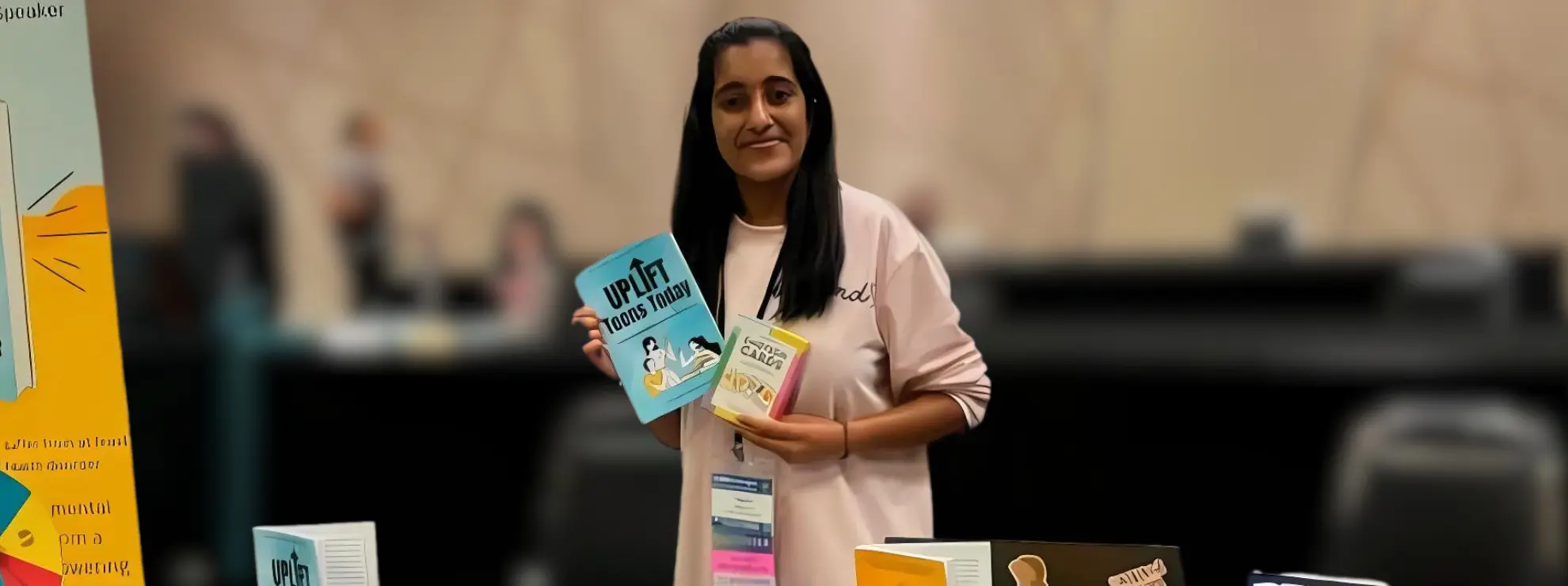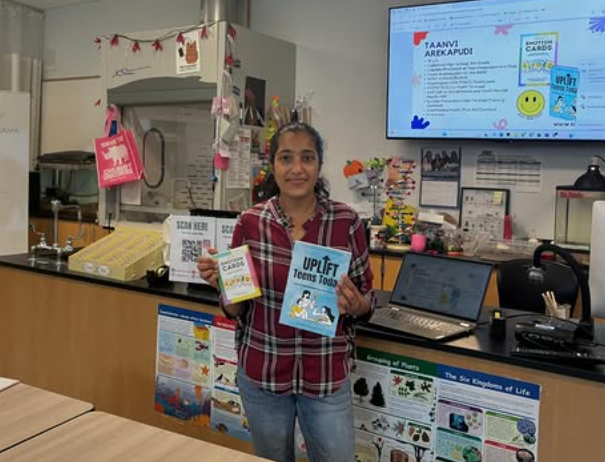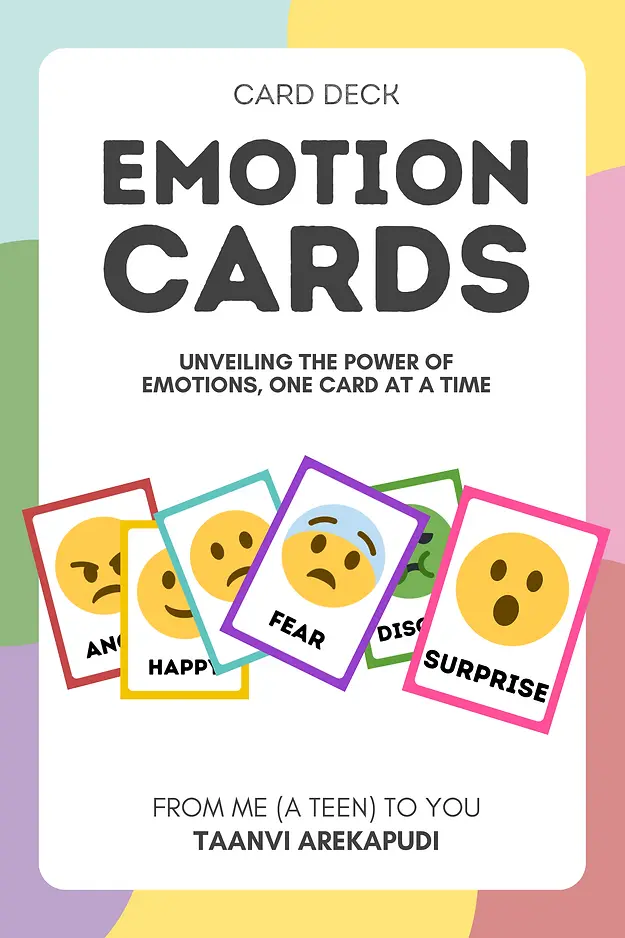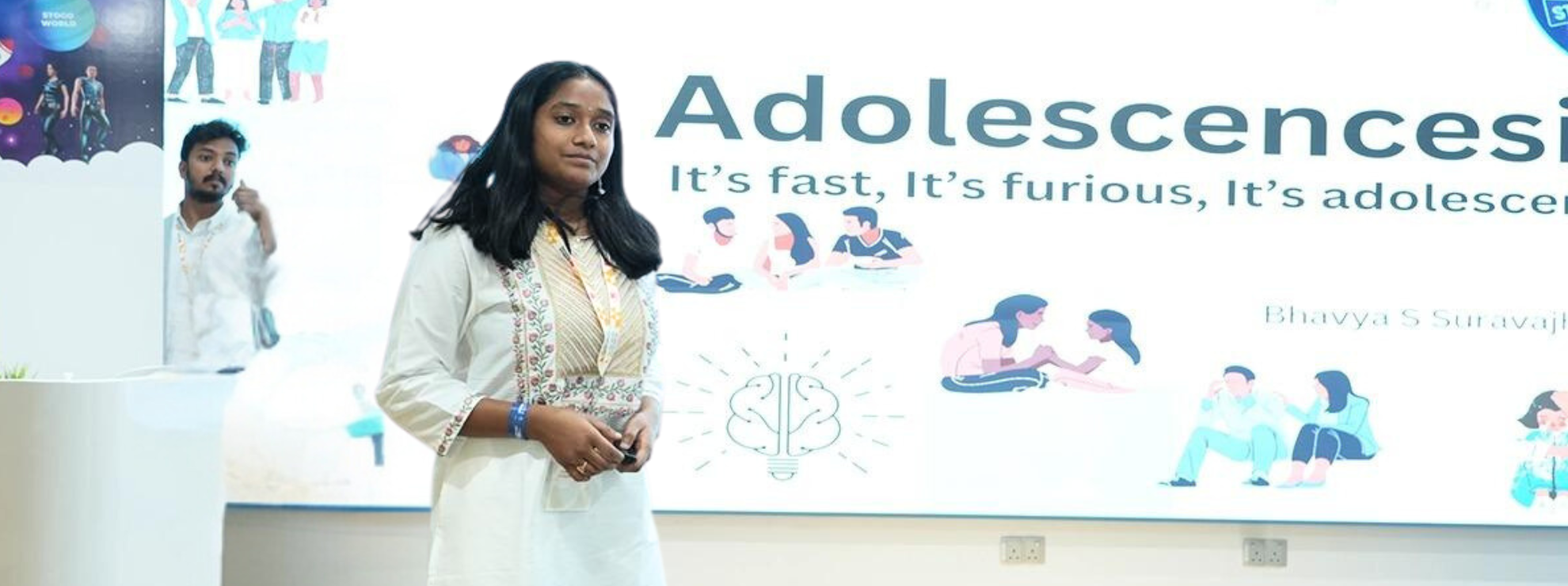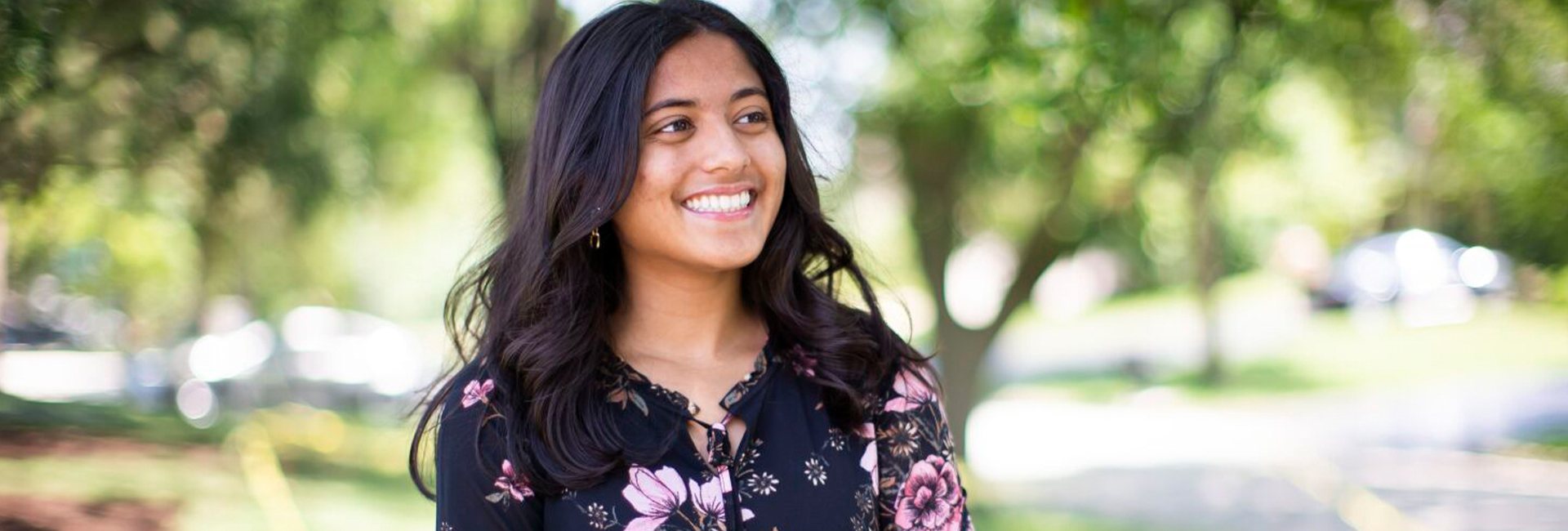(December 12, 2024) Hurried lunches eaten alone in a corner of the cafeteria, endless hours at school spent mostly in silence, her heart racing at the thought of speaking to her peers, and worst of all, having to answer the dreaded question, ‘Where are you from’, made every day a struggle for nine-year-old Taanvi Arekapudi, who is now a passionate advocate for teen mental health. Born in Ireland to Indian parents, then moving to the US at the age of nine meant identity was a complex, confusing concept for the young girl. “A nine-year-old is expected to be happy and excited about life. I would see my peers in the US being that way, and then there was me, faking a smile to fit in, pretending to be happy because that’s what society told me,” Taanvi tells Global Indian.
Now 16 years old, Taanvi greets me with a ready smile that no longer needs forcing. She speaks with courage and insight too, boldly talking about the worst moments of her life and how she learned to find happiness even when everything seemed gloomy. Learning to face herself not only helped her heal, it also gave her purpose. “My mission is to help my peers with coping strategies to use in their daily lives,” Taanvi says.
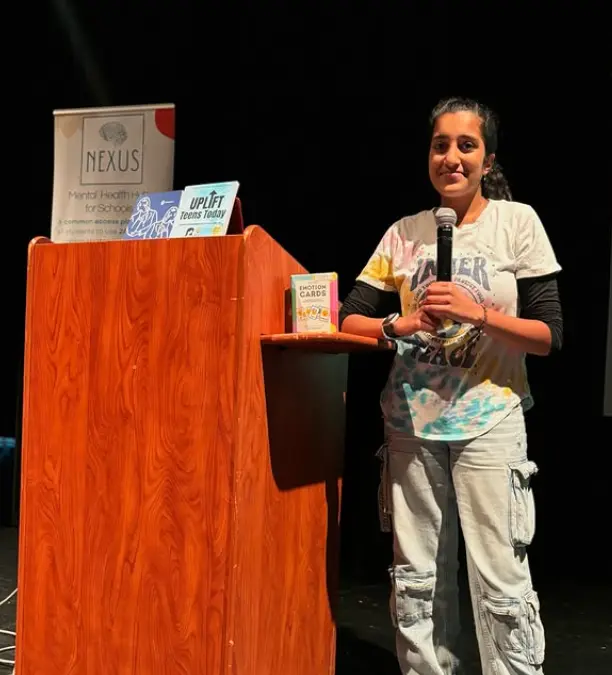
Taanvi Arekapudi
Taanvi Arekapudi is a youth mental health advocate and founder of Uplift Teens Today, a nonprofit providing mental health resources and support to teenagers. Through initiatives like her bestselling book, Uplift Teens Today: Coping Strategies for Mental Health, the Emotion Cards Deck, and the Nexus platform, she empowers peers with practical strategies and creates safe spaces for dialogue. Her work spans schools, communities, and national platforms, breaking stigma and championing youth-led mental health advocacy.
Transformed by challenges
For months, Taanvi hid behind a smile, because she didn’t think anyone would understand. Finally, the dam broke, and when Taavi was at home with her family. “I was scared. What would my parents and my sister think of me. But the first thing my parents told me was, “You’re not alone.” That day, a great weight was lifted off Taanvi’s shoulders. She realised it was okay to feel that way, and to have those emotions—but then what? Get stuck in a loop? That evening, Taanvi’s mom taught her a five-minute mindfulness technique, a guided meditation in which she imagined clouds and rainbows. “It made me feel calm,” she recalls. “I could feel present without worrying about who I would sit with for lunch the next day.”
That was the start of her journey of self-healing. Taanvi had a strategy to help herself and wanted to share this with the world.
The mindfulness journey
Taanvi’s mindfulness meditation brought her peace, and while it could work wonders, she needed more. She began looking for more strategies to help herself, and began her journey of self healing. She learned breathing techniques and regulation techniques, so when she felt a strong emotion, she could acknowledge it and also have a strategy to help herself.
Around that time, the pandmic hit and the world went into lockdown. It was a tough time for everyone, Taanvi Arekapudi included, but this time, she had the strategies she needed to cope with her emotions. She wondered what her friends were going through, and if they were hiding sadness behind their smiles too, as she once had. She asked them how they were feeling, and many admitted they weren’t doing to well. And Taanvi thought, ‘Why don’t I start a club’? The idea was to have students come and share their experiences. It took off immediately, and students were sharing their own troubles, as well as their coping strategies. Her school supported her as well, and many of her peers told her how much it had helped them.
Writing a bestseller
At the age of 13, when her peers were worrying about makeup, school dances, and homework, Taanvi Arekapudi published her first book on teen mental health, written by a teen for teens. She began writing at the age of 12, as a teen reaching out to other teens, hoping to remove the stigma around mental health conversations by sharing her own story. Writing the book wasn’t easy, she admits. She had to be vulnerable all over again, and to relive the emotions and experiences that had troubled her so much. Still, the experience was catharctic.
“At the start, I was sharing strategies along with anecdotes. I had a writing advisor, though, and she told me that it was hard to achieve a flow that way. She suggested that the flow be built around my own stories, with the strategies and challenges interspersed.” So after a year and a half of work, she started afresh. All the while, picturing her book in a reader’s hand kept her motivated. It took another year to complete the work. “There was a lot to learn—I had started off saying something had made me sad or lonely. But then I learned to redo it, and to show what those emotions meant as well. So instead of saying I felt lonely on my first day at school, I wrote that I was sitting by myself in a corner, and how that felt.”
Her efforts paid off and the book was very well received. It was also a genre-maker – most books for teenagers are written by doctors and psychologists. Hers was the first one to be written for teenagers, by a teenager. “I sold thousands of copies, and it was so lovely to see people picking up my book. And I have had countless young people come up to me and say it helped them. Adults did too.”
This was followed by the emotion card set. Children are not taught about emotions—it’s either happy or sad, Taanvi says, adding, “And if you’re sad, you’re told to shoo it away.” It motivated her to create the emotion card set to be used by teens and counsellors to spark conversations about mental health and emotions. It also comes with easy-to-follow coping techniques that are rooted in mindfulness and breathing exercises.
View this post on Instagram
Mental Health Minutes
Three years ago, she created her own curriculum. By this time, Taanvi was visiting schools and spreading the word among her peers. The Mental Health Minutes are a set of monthly strategies where she shares different techniques and how and why to do them.
For this, Taanvi connects with school districts—there are 50 schools in her district in Seattle alone, and teachers share the resources with the students. “Lots of adults create strategies for youth, but they didn’t resonate with me. So I thought, why not share my own? She began making short videos to share with other teens. “Some students love it, others take it in subconsciously, and later, when they are stressed or low, they remember these strategies,” she says. “I have a lot of people coming up and saying they didn’t listen that day but went back to it later,” she says.
With a solid body of work to her credit, Taanvi now works with the University of Washington, where she does research with psychologists there. The aim is to make it part of school curriculums, for which she organizes fairs and recruits student volunteers to spread the word. “And every time I launch in a new district or community, I also launch Nexus,” Taanvi explains.
Creating a curriculum and a global mental health resource library
Nexus is Taanvi’s ambitious project, a free, 24/7 mental health hub for schools that connects students with peer stories, resources, and coping strategies. “It’s already reached 800,000 students nationwide, and I’m working to make it global,” she says. Nexus brings together everything she has created—her book, her emotion cards, and her curriculum—into one accessible platform. “It’s a way for teens to feel less alone and have real tools to help them navigate their emotions.” Nexus’s impact has been widely recognized, earning awards like the Washington Health Care Authority Youth Prevention Project of the Year and the Digital4Good Most Innovative Award. Now available as a website, Taanvi’s plan is to turn it into an app as well.
Her passion for helping others also led her to collaborate on the Inside Out curriculum with the Crown Institute at the University of Colorado. Drawing on the beloved animated movies of the same name, the curriculum teaches emotional intelligence in a relatable, visual way. “I grew up with Riley’s story, so being part of a project like this is so meaningful to me. I want to make sure it connects with teens on a personal level, just as the movies did for me.”
Advocacy at the community and national levels
Taanvi’s work isn’t limited to schools and communities—she has also taken her advocacy to the legislative level. “I had the chance to testify for House Bill 2256 with the Washington Health Care Authority,” she says, her voice filled with pride. “The senators usually give you just 90 seconds, but I was so passionate about the need for more mental health funding that they turned off the timer and let me keep speaking. The bill passed, and it means more resources for youth mental health programs.”
Her advocacy extends into the Indian community, where Taanvi Arekapudi leads mental health-themed talks during festivals at temples. “In India, we’ve always had a focus on mental health, but somewhere along the way, the stigma grew,” she says. “Now we’re bringing that back, connecting the themes of festivals like Diwali with positivity and self-care. It’s incredible to see parents and youth open up after hearing my story and knowing it’s okay to feel this way.” Her temple visits, like all her work, aim to break down barriers and spark conversations.
Taanvi’s impact on teen mental health has also earned her several honors, including the Presidential Volunteer Service Award, the Civic Champions Award, and recognition as a National Young Leader by the National Alliance on Mental Illness. She recently started a raw Instagram series to make her work even more relatable. “It’s unscripted and real—because not everything is perfect. People need to know they’re not alone in what they’re feeling.”
When asked what motivates her, Taanvi smiles. “When I started, I didn’t know if my voice mattered. But now I know that it does—and that’s a message I want every young person to hear. If you have a passion, start advocating. Your voice can make a difference.”

